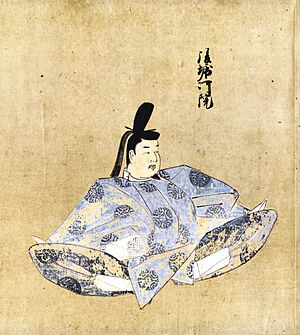Emperor Go-Horikawa facts for kids
Quick facts for kids Emperor Go-Horikawa後堀河天皇 |
|||||
|---|---|---|---|---|---|
 |
|||||
| Emperor of Japan | |||||
| Reign | July 29, 1221 – November 17, 1232 | ||||
| Coronation | January 14, 1222 | ||||
| Predecessor | Chūkyō | ||||
| Successor | Shijō | ||||
| Shōgun | Kujō Yoritsune | ||||
| Born | March 22, 1212 | ||||
| Died | August 31, 1234 (aged 22) | ||||
| Burial | Kannon-ji no Misasagi (觀音寺陵) (Kyoto) | ||||
| Spouse |
Fujiwara no Ariko
(m. 1223)Fujiwara no Chōshi
(m. 1226)Fujiwara no Shunshi
(m. 1230; died 1233) |
||||
| Issue more... |
Emperor Shijō | ||||
|
|||||
| House | Yamato | ||||
| Father | Prince Morisada | ||||
Emperor Go-Horikawa (後堀河天皇, Go-Horikawa-tennō) (born March 22, 1212 – died August 31, 1234) was the 86th emperor of Japan. He ruled from 1221 to 1232.
His name, Go-Horikawa, means "Later Emperor Horikawa." This is because he was named after an earlier emperor, Emperor Horikawa, who lived in the 10th century. Sometimes, he is also called "Horikawa, the second."
Contents
Becoming Emperor
Before becoming emperor, his personal name was Yutahito-shinnō (茂仁親王). He was also known as Motsihito-shinnō.
Go-Horikawa was the third son of Imperial Prince Morisada. Prince Morisada was the second son of Emperor Takakura.
Family Life
Emperor Go-Horikawa had several empresses and ladies-in-waiting.
- His first empress was Sanjō (Fujiwara) Ariuko.
- His second empress was Konoe (Fujiwara) Nagako.
- His third empress was Kujō (Fujiwara) Shunshi.
He had several children:
- His first son was Imperial Prince Mitsuhito, who later became Emperor Shijō.
- He also had three daughters: Imperial Princess Hoshi, Imperial Princess Kishi, and Imperial Princess Taishi.
Key Events in His Reign
Emperor Go-Horikawa became emperor in 1221. This happened because of a big event called the Jōkyū War. The previous emperor, Emperor Go-Toba, tried to take back power from the military government, the Kamakura shogunate. But he failed.
Because of this, the Kamakura shogunate removed Emperor Go-Toba's family from the throne. They forced Emperor Chūkyō to step down. Go-Horikawa, who was a grandson of the earlier Emperor Takakura, was chosen to become the new emperor. He was only ten years old when he started his rule.
- 1221: Emperor Chūkyō gave up his throne.
- 1221: Go-Horikawa became the new emperor.
Since he was so young, his father, Imperial Prince Morisada, helped him rule. His father acted as a "cloistered emperor." This meant he was a retired emperor who still had influence.
In 1232, Emperor Go-Horikawa decided to step down. He passed the throne to his one-year-old son, Emperor Shijō. Go-Horikawa then tried to rule as a cloistered emperor himself. However, he was not very strong and died less than two years later.
Emperor Go-Horikawa's tomb is in Kyoto. It is called Kannon-ji no Misasagi.
Important Court Officials
During Emperor Go-Horikawa's time, there was a special group of very powerful men at the emperor's court. They were called Kugyō (公卿).
These men were usually from important families. They had a lot of experience and helped the emperor with important decisions. This group usually had only three or four members at a time.
Some of the important officials during Go-Horikawa's reign included:
Time Periods During His Rule
The years of Emperor Go-Horikawa's reign are known by different era names or nengō. These were like different time periods used in Japan.
- Jōkyū (1219–1222 CE)
- Jōō (1222–1224 CE)
- Gennin (1224–1225 CE)
- Karoku (1225–1227 CE)
- Antei (1227–1229 CE)
- Kangi (1229–1232 CE)
See also
 In Spanish: Go-Horikawa Tennō para niños
In Spanish: Go-Horikawa Tennō para niños
- Emperor of Japan
- List of Emperors of Japan
- Imperial cult

